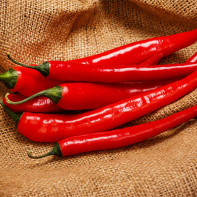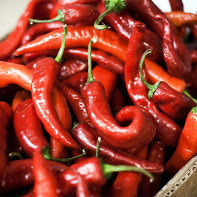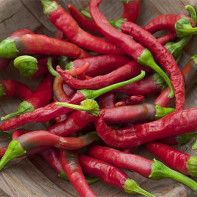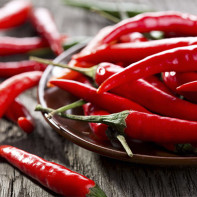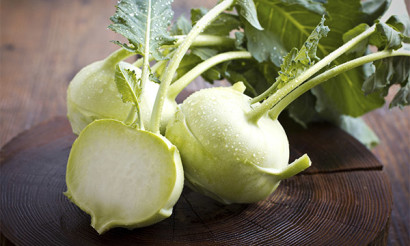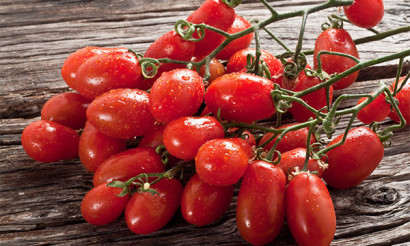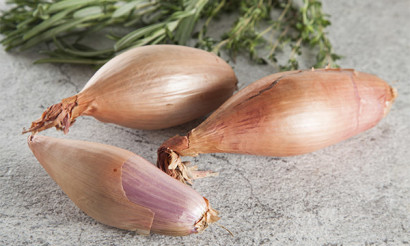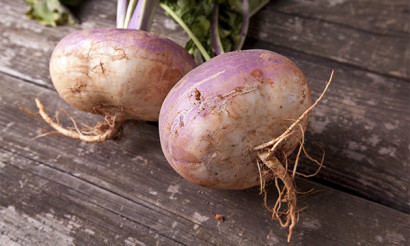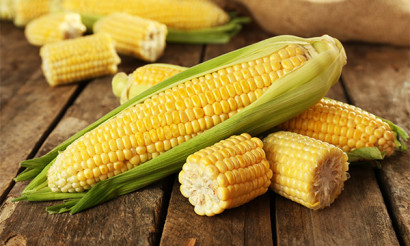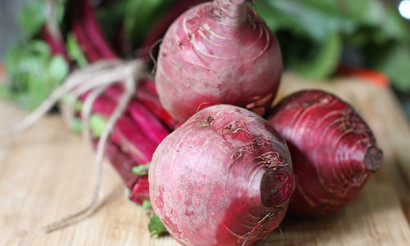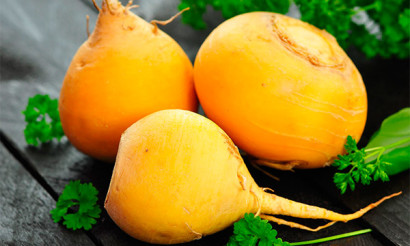Red hot pepper: useful properties and contraindications
For thousands of years, mankind has been using the gifts of nature to maintain health and prolong youth. Herbs, vegetables, roots and fruits are all rich sources of vitamins and minerals that can help people achieve their desired goal. Red hot peppers are no exception. It is not only a spice, but also a great helper in the fight for health. Its history goes back about 3 thousand years. And throughout this time, wise ancestors carefully collected knowledge about this plant, revealing its secrets that can improve human health and prolong youth.
- Types of hot red pepper
- What is the difference between paprika and red pepper
- Which pepper is better: capsicum or powder
- Composition and calories
- How hot red peppers are useful
- General Benefits
- For Women
- For Men
- For Elderly People
- In Pregnancy
- For breastfeeding
- For children
- When losing weight
- Red pepper in medicine
- Diabetes mellitus
- At pancreatitis
- For gastritis
- For the bowel
- For gout
- For the liver
- For cholecystitis
- For colds
- Red Pepper Folk Medicine Recipes
- Red Hot Pepper in Beauty Therapy
- For Face
- For Hair
- For Cellulite
- Cooking
- Hazards and Contraindications
- How to choose and store the red pepper
- Can I Freeze?
- How to Dry
- How do you eat red pepper?
- Can I Eat Peppers Every Day
- Can I Eat at Night and on an empty stomach?
- What can be cooked from hot red peppers: Recipes
- Ajika
- Pickled Pepper "Winter"
- Can we give red peppers to animals?
- What to do if the hot pepper got in the eyes
- Interesting Facts about Peppers
The plant itself can reach a height of 60-70 centimeters. It has a branched stem. During the flowering period, gray with purple or white inflorescences appear. The fruits, which are commonly called berries, come in yellow, red and even dark purple hues.
The native land of the pepper is thought to be the tropics of the American continent. The tribes that inhabited the area used to eat the fruit of the plant and were famous for their health and longevity. With the advent of the Spanish and Portuguese discoverers on the territory of the New World, the red pepper began its journey to distant Europe. This vegetable is also called chili, which actually translates as "red".
Now the spice is very popular, and the leaders in growing and exporting the plant are India and Thailand.
Types of hot red pepper
Traditionally, the pepper is divided into two species: black and red, which belongs to the subspecies Capsikum. In the latter subgroup, the plant is subdivided into red, orange, yellow, white, purple, green bitter and sweet pods, which are united by the presence of a special substance capsaicin. This ingredient is what gives the variety its pungency. Depending on this component, the red peppers are divided into the so-called "no capsaicin", "hot", "spicy", and so on.
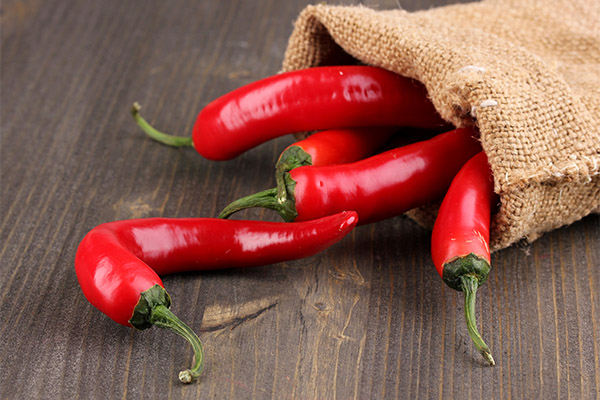
Types with zero pungency include a popular variety of red bell bell pepper. It is almost ubiquitous and can be used as a main dish due to its delicate flavor and lack of bitterness.
Dull peppers have spiciness and a special flavor. It is used as a condiment. This species is grown around Latin America, Indonesia, and the Philippines.
Another type of red hot pepper is tabasco. It became famous because of the sauce of the same name, for which it serves as the basis.
The famous Chinese pepper is used to make hot sauces. It is very popular in China, Asia and America, but it has a rather high degree of spice.
Bhut Jolokia or Ghost pepper is the most spicy of all the red peppers. Its spiciness is incomparable.
In all, the Capsikum species has over thirty subspecies, each with its own degree of pungency, measured using a special scale. This system of measuring the sharpness was called the "Scoville scale" after the name of its creator - the American Scoville. He proposed his development back in 1912. The system has since changed, and the pungency is determined by chemical analysis, but the table or modern scale by which the pungency of the fruit is determined continues to be named after the creator of the first such development.
Despite the fact that peppers, their varieties and types differ in the degree of spiciness, all of them are useful and can help a person to maintain health.
What is the difference between paprika and red pepper
Christopher Columbus should be thanked not only for the discovery of America, but also for the appearance of paprika, one of the varieties of red pepper, on the expanses of Europe and the world. Bulgarian bell pepper is called paprika because it was in Bulgaria that the variety with zero pungency was bred.
The main difference between paprika and red pepper is the amount of capsaicin. Red peppers are sharper than the delicate taste of paprika, which serves as an excellent condiment in cooking. For example, in Hungary paprika is divided into "Noble", "Delicata", "Tender", "Semi-Sweet", "Pink", "Yellow", "Special Sweet". And they all differ from each other in their degree of spiciness. But each is incredibly useful!
Which pepper is better: capsicum or powdered
People who decide to treat or consume peppers to maintain their health quite often wonder which pepper will do the job better.
Experts who have conducted studies on chilli and powdered products have concluded that both chilli peppers have beneficial effects on the human body, and powdered peppers can also handle some health benefits.
In terms of convenience, powder is much more convenient when it comes to time, but if you look at the beneficial substances contained in the vegetable, chillies are much healthier. It contains the full amount of capsaicin, but in the powdered spice it is much less, and therefore the spiciness of products will be different. Therefore, if you need a spicier pepper or for medicinal purposes, you should choose a capsicum pepper and use the powder as a spice.
Composition and calories
Hot pepper is a valuable vegetable, which includes such vitamins and minerals:
- B vitamins, A, C, E, K, PP;
- iron;
- copper;
- phosphorus;
- calcium;
- magnesium;
- omega-6;
- capsaicin;
- selenium;
- organic acids;
- sterols.
Nutritional value per 100 grams of vegetable is 40 kcal, 9 g of carbohydrates, 2 g of protein and 0.2 g of fat.
Thus, it is unlikely that you can eat too much pepper, but the taste of the dish will become brighter, and the benefit will increase twofold!
What are the benefits of red hot peppers?
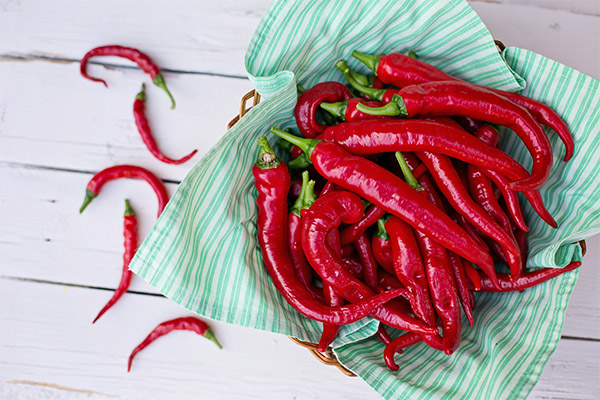
General Benefits
The composition of the spicy vegetable is rich in nutrients that have a positive effect on the human body as a whole. Pepper is able to cope with the following problems:
- eliminate tooth, heart, and joint pain;
- normalize blood circulation;
- reduce blood pressure;
- Improve the intestinal tract;
- protect against cancer;
- enhance immunity;
- prevent blood clots;
- calm the nervous system;
- Improve digestive processes and liver health;
- Reduce weight and cholesterol levels;
- Relieve symptoms of allergies and asthma;
- Treat arthritis, sciatica;
- Deal with skin diseases.
The composition of pepper makes it possible to use it to improve almost all the vital processes of the body. But it is worth noting the effect of pepper on women's, men's and children's health.
For women
The fair sex should use the pepper for disorders of the genitourinary system. The vegetable perfectly eliminates inflammation and foci of infection. Also, it will help to adjust the menstrual cycle, but during the very critical days it is not necessary to use it (especially at the beginning), because. The painful sensations may intensify, and the discharge may become more profuse.
Well, for a woman's youth and beauty, burning "beauty" is simply indispensable. Cellulite, overweight, weak hair and nails, flabby skin - it copes with all these problems perfectly.
For Men
For men, the use of red pepper can enhance potency, give strength and increase stamina. In addition, the members of the stronger sex who are addicted to alcohol, red pepper will help reduce the harmful effects of alcohol on the liver. And for those who are afraid of baldness, pepper will help not to lose the rest of the former hair. So also men should not bypass the burning spice.
For the elderly
Older people are especially in need of good health. To maintain it, it is necessary to regularly consume a minimum amount of red hot pepper, which can prolong life, prevent the emergence and development of disorders and diseases characteristic of the elderly. Also, the vegetable strengthens the walls of blood vessels and regulates the activity of the cardiovascular system, which is very important in old age. For those who suffer from digestive disorders and constipation, the use of a spicy spice will also be very useful.
But do not forget that the body of an elderly person is quite fragile, so you should consult your doctor to establish the possibility and the norm of taking pepper.
When pregnant
Pregnancy is a stress for the female body and a responsible time when you need to monitor the benefits of the products included in the daily diet. Peppers, of course, are good for your health, but not while you are expecting your baby. Consumption of the vegetable can increase muscle contractions, which leads to complications. Also from the pepper causes pain and heartburn, and this is also an unnecessary problem in pregnancy. Therefore, it is worth refraining from consuming red peppers altogether.
When breastfeeding
During lactation, experts do not recommend the use of the vegetable, because it can harm the newborn. When getting into breast milk, and then into the body of the baby, the pepper causes heartburn, diarrhea and colic. And this is not only sleepless nights, but also the health of the little man!
For children
Medics allow the use of the product only from the age of thirteen. At the same time, you can not treat a teenager with a stinging variety. You should give a taste of not too spicy vegetables, so that there is no risk of mucosal burns. It is also worth consulting a doctor to determine exactly how and how much chili you can consume.
For weight loss.
Capsaicin, which is part of the vegetable, activates the process of producing enzymes that can burn fat and increase the metabolic rate of the body. The hotter the pepper, the more capsaicin, and therefore the greater the effect in weight loss. Also, pepper reduces appetite, not allowing you to gain extra calories, and increases thirst and the amount of water you drink. It is also known to be a necessary component of any diet.
Therefore, red pepper, regardless of the form in which it is consumed (capsules, fresh, powder), perfectly helps to cope with hateful pounds.
Red pepper in medicine
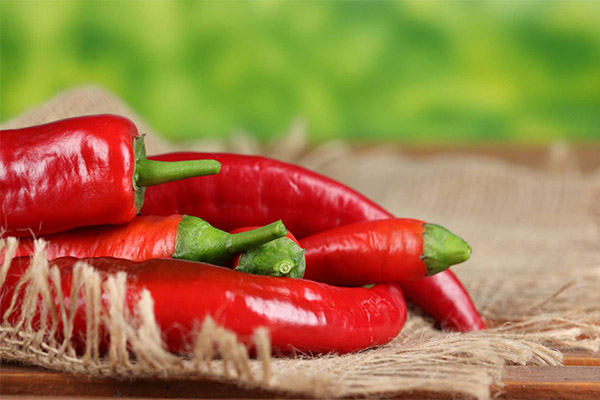
Medicine since ancient times knew about the healing properties of red pepper. Nowadays, the use of the vegetable successfully helps to get rid of and contribute to the treatment of the following diseases:
- acute respiratory viral infections;
- pneumonia;
- helminths;
- sciatica;
- cellulitis;
- atherosclerosis;
- rheumatism;
- hypertension;
- nervous disorders;
- malignant tumors;
- flatulence;
- gout;
- disorders of the large intestine.
The list is quite long, so the effect on some diseases is worth considering in more detail.
In diabetes
With diabetes, patients have to cope not only with the main diagnosis, but also with related ones - deteriorating vision, excess weight, high blood pressure, lack of vitamins. With such symptoms, hot pepper suffers well, but its use for patients is possible only once a week and in certain doses, which depend on the individual characteristics of the body. Therefore, before introducing the vegetable into the diet, be sure to consult with your doctor!
Important: The glycemic index of red hot pepper is 45 units.
In pancreatitis
Pancreatic disease requires a strict diet with the exception of fried, spicy, spicy and fatty foods. Red pepper, despite all its merits, is categorically contraindicated for people suffering from pancreatitis. Its intake can aggravate the situation and provoke an attack even in the period of remission. That's why in this disease the inclusion in the menu of hot pepper or spices based on it is strictly contraindicated!
With gastritis
Patients diagnosed with gastritis are also forbidden to consume chili peppers, in any form, because even during the quiet course of the disease, it can not only cause a new and strong attack, but also become the cause of bleeding. Therefore, this vegetable and spice should be abandoned for the benefit of your own health!
For the intestines
Hot red pepper is very useful for the intestines, because it helps cleanse them from sluggishness, sets up the process of defecation, eliminating constipation due to the laxative effect, reduces flatulence and helps get rid of colic. Of course, this does not mean that you should eat peppers every day and by the kilogram. It will be enough to eat one peppercorn once a week or season your favorite dish with a spicy seasoning.
In case of gout.
Such a severe disease as gout, which is characterized by an excess of uric acid, requires close attention and a special diet prescribed by the doctor, depending on the characteristics of the patient's body. The consumption of hot pepper in food is quite possible, because it can reduce swelling, cope with digestive problems and reduce inflammation. It can also have a positive effect on the production of enzymes that neutralize acid. Tinctures and compresses with the burning vegetable will cope with arthritis arising from this disease. But before introducing the pepper into the diet, it is necessary to consult with a specialist to avoid negative consequences.
For the liver
Thanks to the flavonoids that are part of the hot chili, the liver can repair damaged tissue. The vegetable can also protect against fibrosis. Its daily consumption is beneficial to the organ and can even cure hepatitis. It is capsaicin that can work such miracles. It regulates the proliferation of liver cells, responsible for the removal of toxins, as well as preventing the proliferation of those that can lead to damage to the organ. But the use of the product should be in doses not exceeding those recommended by the doctor, and in the absence of problems and contraindications.
In cholecystitis.
Cholecystitis is an inflammation of the gallbladder, in which the diet is also important for speedy recovery. The diagnosis itself is a strict ban on the use of red peppers and hot spices.
For colds.
Since chili has excellent warming properties, increases the body's resistance to seasonal viral infections, as well as activates the immune system, it will be an excellent helper when you have a cold, helping to quickly get rid of the symptoms of the disease and recover. It is usually recommended to boil a centimeter-long piece of the vegetable in a glass of milk, then remove it, drink the liquid and sweat properly. The cold goes away, but the health stays!
Traditional Medicines Recipes for Red Pepper
The wisdom and knowledge of ancestors, accumulated for thousands of years of human existence, have found their application in folk recipes, which use not chemical derivatives, but natural ingredients that can heal.
Red pepper has been used since ancient times by folk healers. Its miraculous power helps patients to cope with diseases on a par with medical treatment:
- To get rid of gout, herbalists advise combining pepper with vodka in a ratio of 1:7 and allow to infuse for 7 days. This elixir is used to lubricate the joints.
- To preserve youthfulness, it is recommended to mix 500 grams of vegetable oil, 200 grams of liquid honey and 1 tsp. red pepper. Take a potion of 1 tbsp. 5 times a day. Continue the treatment until the mixture runs out, and repeat the procedure in 3 weeks.
- To fight a cold in the beginning, you need to insist for 7 days a mixture of 500 ml of vodka and 1 chilli pepper. Use such a medicine by a quarter cup at the first symptoms.
- Radiculitis recedes if the foci of inflammation rubbed with a tincture of 1.250 ml of ammonia and 2 red peppercorns, infused for 2 weeks.
- The runny nose will disappear if you wrap your feet at night with a gauze cloth pre-soaked in pepper tincture. Wrap your feet in warmth and go to sleep in woolen socks.
- To get rid of sore throat with sore throat and pharyngitis 4 tsp. honey mixed with 0.5 tsp. ground red pepper and 4 tsp. water. Such medicine should be taken twice a day.
- You can get rid of parasites with red hot pepper. To do this, combine 30 grams of red hot pepper, 100 ml of alcohol and 400 ml of water. Keep the drug in the refrigerator for 3 hours, and then use for 10 days, 10 drops per day.
- Such a disease as psoriasis is treatable with the use of a red hot vegetable. Mix the fresh pepper, grind it to a homogeneous mass and add a little water. Such a remedy is applied to the damaged areas to relieve inflammation, redness and get rid of unpleasant symptoms. But this medicine should not come into contact with the skin for more than 10 minutes.
- Genital herpes is a rather unpleasant thing, but you can also cope with it with the help of red hot pepper. To do this, place three to five stinging fruits in a liter jar and pour vodka up to the full volume. Then insist the potion for 2 weeks in the dark. After that, take the medicine by 1 tbsp. 2 times a day, diluting it with water for a speedy recovery and to avoid the risk of burning the mucous membranes.
- With a toothache, infuse pepper in vodka in the proportion of 1:20. This remedy is dripped on a cotton swab and applied to the painful tooth. Only two drops are needed.
- People who suffer from pain in the joints, a remedy prepared from red pepper, vodka, vegetable oil will help. Require 4 pieces of pepper, 500 ml of vodka and 350 ml of oil. To prepare the solution, pour the pepper with vodka and let infuse in a dark place for 2 weeks. Then filter the tincture with gauze and add oil. The resulting product rub the sore spot.
- The heel spur can cause a lot of pain, but red pepper will help to cope with this trouble. To do this, it is recommended to put in a sock one pinch of ground pepper and walk in such a sock for a day. The procedure should be repeated for 10-15 days. Usually the pain disappears after two weeks.
- Pneumonia is a serious disease that must be treated with medication, but the help of folk medicine is not excluded, which can lead to a faster recovery. To fight the symptoms of pneumonia, you need to mix in a glass of milk a pinch of pepper, saffron, ground ginger and boil everything. Consume the decoction at night.
Such folk recipes help people to maintain their health and fight diseases, without harming the body.
Red hot pepper in cosmetology
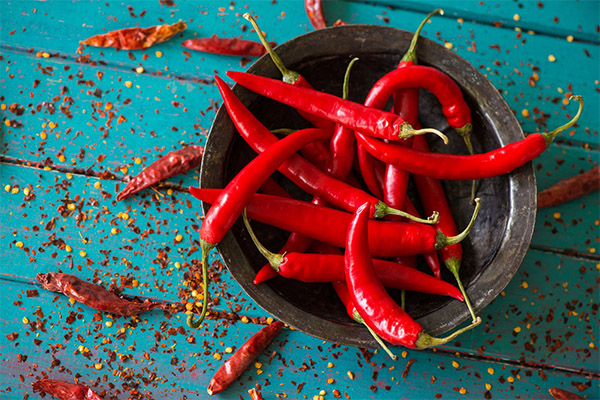
Red chili has proven its advantage not only in medicine, but also in the cosmetic field. It is able to preserve youth, helping the skin to become firmer and healthier. Pepper also gets rid of age spots and saturates epidermal cells with useful microelements. Its main properties include the ability to activate hair growth by regulating the activity of hair follicles. In addition, the useful substances of the vegetable perfectly cope with the problems of brittle and flaky nails, strengthening them from the inside. Thanks to its merits, pepper has become a major component in many cosmetic products, which you can not only buy in the store, but also make yourself.
For face
Nourishing Mask
Components:
- 3 red peppers without seeds.
- Carrot juice.
- Tbsp. cabbage juice.
Grate the pepper and mix with the rest of the ingredients. Apply to face and keep for 10 minutes. Then clean your face with a cotton pad and wash your face with warm water.
Rejuvenating
Components:
- Egg - 1 piece.
- Pepper tincture - 1 drop.
- Sour cream - 1 tbsp.
Mix all the ingredients with each other and apply the composition to the skin. After 15 minutes, wash your face with warm water, then rinse with cold water. After the procedure, wipe the skin with a towel is not recommended.
Tonic
Components:
- Pepper tincture - 7 drops.
- Mineral water - 200 ml.
- Peach oil - 10 ml.
Mix the components and pour the liquid into a prepared cosmetic bottle. Wipe the skin with a cotton pad in the morning and evening.
Brightening
Components:
- Lemon juice - 10 drops.
- Fresh red pepper (hot).
Pepper is cleared of seeds and grind with lemon juice until a homogeneous mass. Such a mixture to put on the problem areas and keep 20-25 minutes. After that, remove the composition with a damp cotton pad. Wash your face only after 60 minutes after removing the mask.
For pale skin
Ingredients:
- Beeswax - 1 tsp.
- Olive oil - 1 tbsp.
- Butter - 1 tsp.
- Red hot pepper - ¼ small pod without seeds.
Grind the pepper until homogeneous and mix with olive oil. Melt the wax and add butter. Then combine all the components and apply the product to the face. At the same time the mixture must be warm. Wash off with warm water after 5-10 minutes.
For Hair
Combat hair loss
Ingredients:
- Pepper tincture - 1 tsp.
- Olive oil - 3 tbsp.
Combine all ingredients and apply to the scalp for half an hour. Wash off. Repeat the procedure 2 times within seven days. The course of 14 days.
Against itching
Components:
- Liquid honey - 4 tbsp.
- Ground red pepper - 1 tbsp.
Warm the honey slightly and combine with the pepper. Rub the composition into the damp scalp, then put on a cellophane cap and wrap it in warmth for 30 minutes (if it burns a lot, wash it off earlier). Rinse with warm water. Frequency of use of the mixture - twice a week.
Against dandruff
Components:
- Decoction of chamomile - 4 tbsp.
- Calendula decoction - 4 tablespoons.
- Pepper tincture - 2 tbsp.
To mix the ingredients and distribute on the scalp. Leave on for half an hour and wash your head with a natural shampoo.
For hair growth
Components:
- Hot pepper - 10 gr.
- Alcohol - 100 ml.
Combine the ingredients and insist for 7 days. Then dilute the composition with water in a ratio of 1:10 and apply to the scalp 3 times a week before bedtime.
Growth Boosting
Components:
- Burdock oil - 1 tsp.
- Castor oil - 1 tsp.
- Tincture of pepper - 1 tbsp.
After all the components have been mixed, apply the composition to the hair and wrap with a cap and towel. Sustain for 60 minutes and rinse your head with warm water.
For cellulite
Scrub
Ingredients:
- Ground coffee.
- Pepper tincture.
- Olive oil.
Combine the ingredients in a ratio of 1:1:1 and apply to the problem areas of the body. Rinse with cool water.
Wrap
Ingredients:
- Honey - 3 tbsp.
- Ground red pepper - 1 tsp.
Mix the ingredients and apply to the skin. Wrap the wrap in clingfilm and wait for 15 minutes. Rinse with cool water and apply cream.
Mask
Ingredients:
- Blue clay (can be black) - 3 tbsp.
- Red pepper - 0,5 tbsp.
- Coffee grounds - 4 tbsp.
Dissolve the clay with water and add all the other ingredients. Apply the mixture to the areas which require special attention and wrap it up with clingfilm. Allow the mixture to remain on for 10-15 minutes and then rinse off with water.
Spicy
Ingredients:
- Olive oil - 50 ml.
- Cinnamon powder - 2 tablespoons.
- Ground hot pepper - 2 tablespoons.
Apply the mixture of the above components to the skin with a spatula and wrap in cling film. Wait 15-20 minutes and rinse with warm water.
Cooking Applications
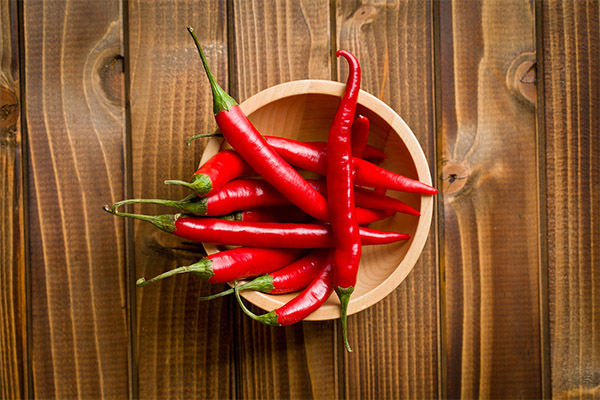
Red pepper is, first of all, a vegetable, so it is natural that in the beginning it was used specifically for food. Today it makes an excellent seasoning that can diversify meat dishes. It is good for mixing with spices and seasoning sauces that will take on a spicy and bright flavor. Pepper is also added to salads and spicy soups. It is pickled and eaten fresh. And pickled product is as useful as fresh, but the bitterness in it is less noticeable.
In addition, confectioners often use red pepper to make dark chocolate, which gives the popular dessert a refined taste. The spice is also added to baked goods, but in minimal doses.
Red pepper goes well with alcoholic cocktails and warming drinks.
The properties of red hot peppers are unique, so cooks, adding a vegetable and seasoning from it, prepare not only tasty dishes, but also useful!
Harms and contraindications
Despite the fact that chili is known for its benefits, it has a number of contraindications, in which its use is not only not shown, but can also bring great harm to health. These are the kinds of consequences that peppers can lead to if taken by people with the following disorders and diseases:
- gastritis;
- colitis;
- enterocolitis;
- peptic ulcer disease;
- kidney disease;
- cholecystitis;
- pancreatitis;
- diabetes mellitus;
- Children under 13 years of age;
- Pregnancy and lactation period;
- individual intolerance.
Under these conditions, the use of pepper is strictly prohibited. Dietary adjustments are possible only after consultation with a specialist!
How to choose and store red peppers
There are no serious complaints about the choice of peppers. When buying, experts advise to inspect it for cracks and extraneous dents and inclusions, which should not be there. The skin of the vegetable is smooth and bright red in color, and dark scarlet when dried. The density of the fresh product is quite high. In this case, it is better to refuse too hard or too soft peppers.
Fresh product is stored in the refrigerator for a week, but if you oil or vinegar, you can extend the shelf life up to one month. But the dried vegetable and seasoning from it can retain its qualities for a whole year.
Can it be frozen
Red peppers freeze just fine and don't lose their vitamins. In a frozen form it can delight the owners all year round. To freeze the product, you need to follow the following rules:
- Rinse the pepper thoroughly and remove the seeds and membranes.
- Cut the fruit into small strips.
- Pack the raw material in a bag or container, tightly and hermetically sealed.
- Put it in the freezer.
Such peppers can be added to dishes to decorate them and improve their health.
How to Dry
It is known that dried red peppers are stored longer than fresh products and can for 12 months bring benefits and taste pleasures for those who like to eat "spicy". To do this, you can dry the vegetable at home.
Before you start drying, you should prepare the peppers:
- Collect the fruit without surface flecks and damage. The color of the vegetable is not important.
- Wash and remove impurities.
- Those who like spicy, you can dry the vegetable as a whole, and people who are wary of excessive spice, it is recommended to cut the fruit in half and remove the seeds and membranes.
- You should also remember that you must wear rubber gloves when working with hot varieties of pepper to avoid burns, which you can get after twenty minutes of contact with the burning "beauty".
Next you can proceed to drying. There are three ways to dry peppers: outdoors, in an oven, and with an electric dryer.
In the air. Such drying is simple and does not require any special skills. The sun will do everything by itself. The only thing to consider is sunny and dry weather. If the rains are expected, then you can also dry the vegetable indoors, where it is dry and dark. The process itself takes about 2 weeks.
Outdoors, peppers are dried in two ways: horizontally and in garlands. For the first method, you will need paper that absorbs moisture (newspaper or napkin). On it lay the product separately from each other and turn it every day. Change the substrate once every three days. During the night, cover the peppers with a cloth to avoid insects and dewdrops
Drying with garlands involves stringing the peppers on a fishing line or thread by the stalk with a needle. Vegetables should not touch. Such a construction is hung in a room with good ventilation.
Dry peppers in the oven for 5-10 hours. To do this, put the fruits on a baking tray, covered with paper, separately from each other and put in an oven with a temperature of 50-60 ° C. In the process of drying the door should be ajar, and the peppers need to watch and turn it
The electric dryer will do everything by itself in 10-12 hours. You should lay out the peppers, avoiding contact with each other, turn them periodically and wait for the time to elapse.
How to eat red peppers
In order to prevent peppers from harming the body, you should eat them correctly. The easiest advice the experts give is to add a spicy vegetable to a soup or side dish. In this case, dishes of potatoes or rice, as well as bread, can smooth out the spicy "impression. If you do not want spice, then the pepper should be cut and remove the seeds, as these are the carriers of capsaicin. In this form, the bitterness will be bearable. If the spice is unbearable, you should drink ice-cold liquid or milk, which reduces the sensitivity and envelopes the lingual receptors.
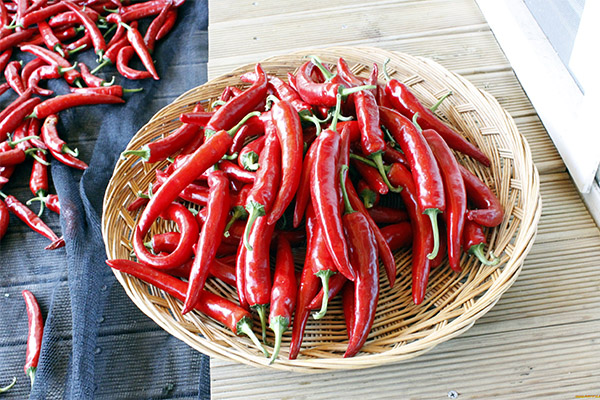
Can I Eat Peppers Every Day
Hot pepper, of course, is very useful in any form, but still you should not get carried away with it, because its effect on the mucous membrane of the stomach is great and can cause its inflammation and irritation. It is for this reason, experts recommend using the vegetable no more than 2 times in 7 days. Such a regime of eating peppers will not create additional stress and risk on the body, but only have a beneficial effect and help improve health.
Can I Eat a Bell Pepper at Night and on an empty stomach?
If you can eat bell peppers at bedtime, you should be careful with the hot varieties. Although red hot pepper has a low calorie and low glycemic index, but it is still a burning product, and dieticians and physicians do not recommend to eat any spicy food at night. The fact is that such dishes, and pepper is no exception, retain fluid in the body, so edema can occur in the morning. In addition, the use of hot peppers before going to bed can provoke heartburn and colic attacks. Also the desire to quench thirst, which is provoked by red pepper, will make your sleep intermittent and restless. It is for these reasons you should refuse to take hot peppers at night.
It is worth noting that chili peppers are among those products that should not be taken on an empty stomach. It can cause damage to the gastric walls and intestinal mucosa, as well as being a provocateur in the development of ulcer disease. It is still better to eat peppers little by little and as a condiment or addition to the main dish.
What can be made from hot red peppers: recipes
Chefs and cooks use peppers to spice up dishes, decorate, whet the appetite, make sauces and marinades. Regular housewives aren't left out either. They use peppers for preserving for the winter, and it can be both an independent "twist" and one of the components included in the main dish. Most often peppers are used for cooking the famous adjika, vegetable salads, marinades, as well as meat and rice.
Ajika
Ingredients:
- 500 g of hot red chillies.
- 300 grams of garlic.
Wash peppers and remove seeds. Peel the garlic as well. Put everything through a meat grinder or puree with a blender. Salt, if necessary, and put in jars. Storage such adzhika put in the refrigerator.
Pickled pepper "Winter"
Ingredients:
- 0.5 tbsp. salt.
- Red hot pepper.
- 1 tbsp sugar.
- 50 g 9% vinegar.
This recipe is designed for a liter jar. The number of peppers is taken from the calculation of the dishes.
Preparation of .
Clean peppers tamped in a sterilized container and fill it with boiling water. With the lid on, let it infuse for 15 minutes. Then pour the water into a saucepan, add sugar and salt and boil it. Next, pour the vinegar into a jar and pour the marinade there as well. The container to screw up and put it to cool in the heat.
Can I give red peppers to animals
Consuming red hot peppers in animals risks not only irritation of the stomach mucosa and digestive problems, but also damage to the gustatory functions and sense of smell. For these reasons, animals should not add spicy condiments to their food.
What to do if hot peppers get into the eyes
When working with hot peppers, you must be extremely careful and use gloves. Hands should be washed thoroughly after work. If contact with the burning substance in the eye cannot be avoided, first aid should be given. To do this, you should first rinse your hands thoroughly to avoid re-introducing capsaicin to the mucosa. Then use a cotton pad soaked in olive oil and apply a compress to the eye. Once the burning has subsided, drip eye drops.
You can also use the following folk methods to help cope with burning sensation when a red pepper burns in the eye:
- Soak a cotton pad with a strong tea solution and then wipe the eye.
- Decoction of chamomile or calendula works well. This may be soaked in water that the victim is able to dip his head into it and blink on the affected eye.
- Milk can also help if dripped with an eyedropper over the injured area. It will flow out, thereby expelling the burning element.
After such procedures, you should also put drops in your eyes that can relieve inflammation. If the symptoms do not go away, you should definitely seek help from a specialist.
Interesting facts about pepper
The long history of the existence of pepper has accumulated many interesting facts about this culture:
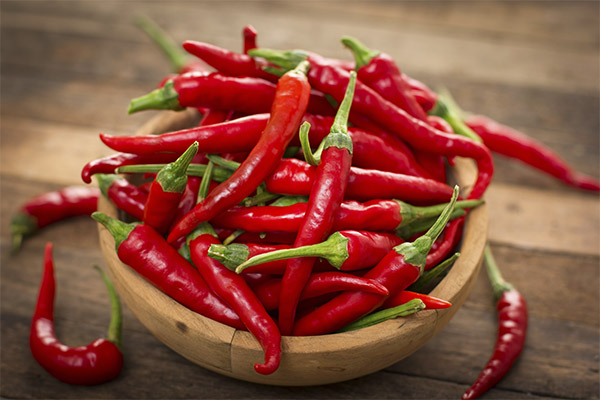
- Hot peppers are absolutely harmless to birds, they do not feel the spiciness, as the seeds of the fruit enter their bodies in whole form.
- To make the plumage of several species of canaries get a bright red hue, it is customary to treat birds with cayenne pepper.
- On the territory of Russia pepper became known only in the 16th century.
- The first mention of pepper is 3 thousand years old and is written in Sanskrit.
- Marcus Aurelius, ruler of legendary Alexandria, first imposed a tax on pepper, which was brought by traders to his city.
- Pepper was the most expensive condiment in the world until the 17th century.
- In the days when pepper was equated with precious metals, housewives, in order to avoid suspicions of theft of this unique spice by their servants, used to grind it themselves and store it in a hidden place, while the "delicacy" was given to the kitchen.
- The substance capsaicin contained in pepper is able to evoke joyful feelings, because it, like sugar, can activate the release of serotonin, which is commonly called the "hormone of happiness".
So pepper is an ancient crop that has been known since times immemorial and is able to help maintain human health. Its useful qualities and rich vitamin and mineral complex have made it one of the most popular and favorite spices in the world. Its bright and bold taste gives dishes not only spiciness, but also endows them with human health benefits, as well as helping to preserve beauty and youth!
«Important: All information on this site is provided for informational purposes only purposes. Consult with your health care professional before applying any recommendations. specialist before using the recommendations. Neither the editors nor the authors shall be liable for any possible harm caused by materials."

